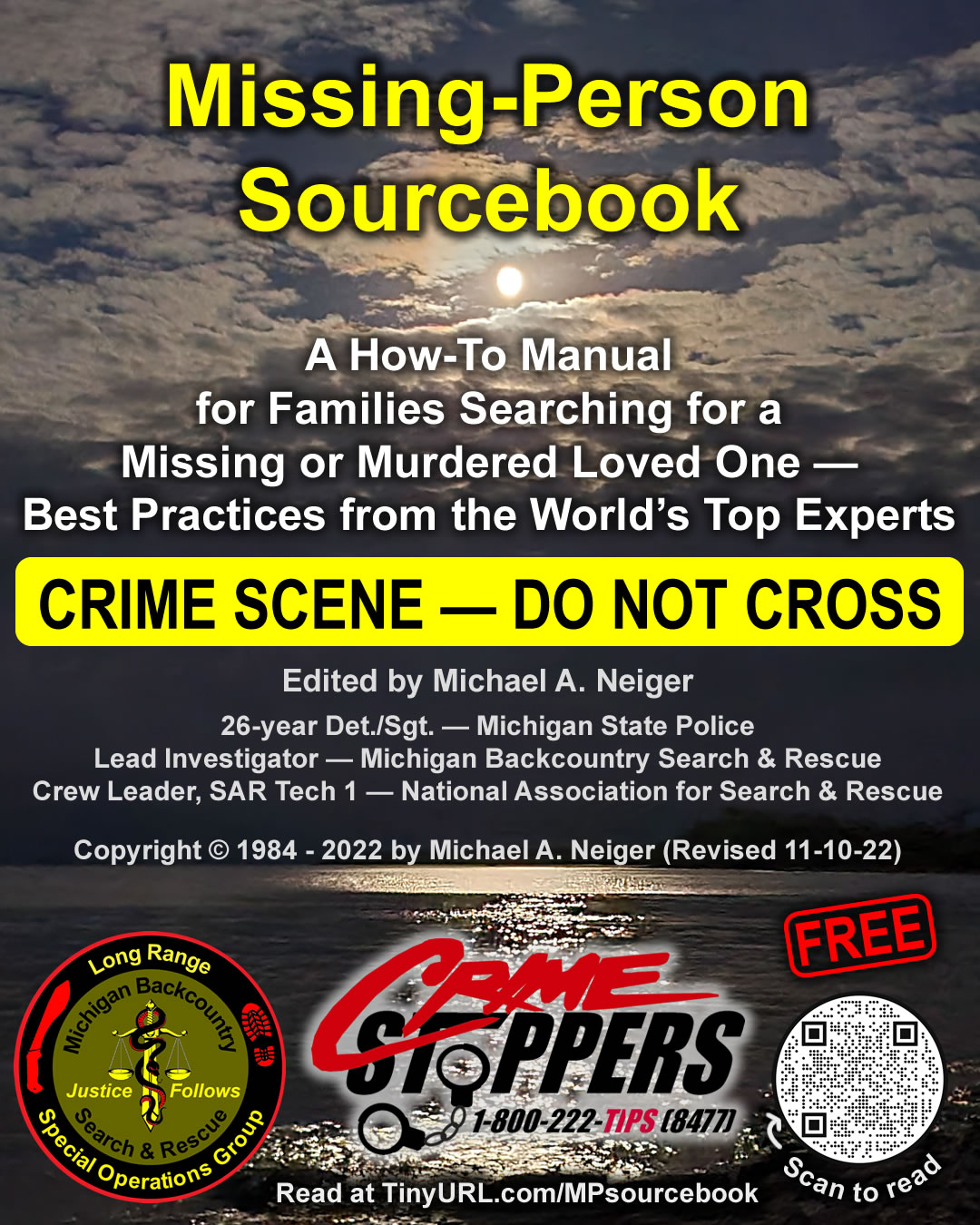
You're here: MibSAR :: M-P Sourcebook Table of Contents :: Social Media
How to Use Social Media to Build Awareness of Your Loved One's Case
| << Prior Chapter | Next Chapter >> |
Social media can be used by families to build awareness of their loved one's case.
Page contents:
- The SOS Guide: Missing Persons — A Guide for the Families and Friends of Missing Persons, by the National Missing Persons Coordination Centre (NMPCC), Australian Federal Police (AFP), 2017, 34 pages.
- Long-Term Missing Child Guide for Law Enforcement: Strategies for Finding Long-Term Missing Children, edited by Robert G. Lowery, Jr., and Robert Hoever, National Center for Missing & Exploited Children (NCMEC), 2016, 226 pages.
- Missing Persons Cases: Proactive Media Guide, by the National Missing Persons Coordination Centre (NMPCC), Australian Federal Police (AFP), 2017, 2 pages.
- Families of Missing Adults: Finding Help, by Ontario's Missing Adults (OMA), Department of Justice Canada (DOJC), 2015, 22 pages.
- Missing Persons Guide: Facebook, by the Missing Persons Advocacy Network (MPAN), Melborne, Victoria, Australia.
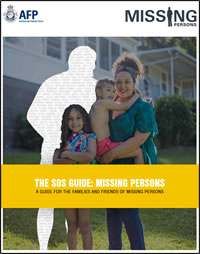 |
|
| The SOS Guide: Missing Persons — A Guide for the Families and Friends of Missing Persons, by the National Missing Persons Coordination Centre (NMPCC) | |
Social media
Social media can be a powerful tool to raise awareness of missing person’s cases. Before starting a social media campaign, speak with your case officer and think about the long-term implications it may have for you and your family. Things to consider include:
- Public access to information: Information shared in the public domain is hard to control. Once information is on the internet it can be freely shared and used by others. If and when your loved one returns, it can also be difficult to remove information from the public domain.
Sharing identifying details and updates about the case may also jeopardise the investigation or alert perpetrators to potential police activity or enquiries.
- Long-term commitment: Starting a social media account or campaign is a long-term commitment. While it’s great to have community support and many people helping you search for your loved one, be aware that people who join your campaign will be eager for news.
You may get regular emails or messages from people requesting updates and new information which can be distressing if there is no new information for periods of time.
You may also experience ‘trolls’, and others who post negative comments about the missing person. While you can eventually block and report these people, the experience can be distressing.
Consider sharing the responsibility for monitoring social media sites with friends or relatives to help ease the burden.All calls for information should be directed to Crime Stoppers (1800 333 000). They will provide the information to police.
Providing the public with your private details, or overly engaging within message platforms, is not advised.
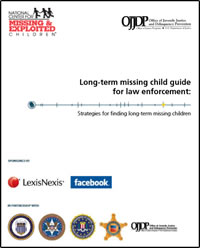 |
|
| Long-Term Missing Child Guide for Law Enforcement: Strategies for finding long-term missing children, edited by Robert G. Lowery, Jr., and Robert Hoever | |
Embracing social media to help with the search
Although traditional media coverage is critical in disseminating pictures of and information about a missing child, it’s important to consider working with all types of media.
Traditional TV, print and radio media outlets can reach tens of thousands of homes, but social media can be the most important and flexible tool for the family of a missing child.
Social media can make a dramatic impact at the beginning of a missing child investigation, but it is also an important tool for families when they experience a decline of media interest.
It may also be the only resource when law enforcement is left with diminishing leads or options.
As mentioned in earlier chapters, the family of missing a child is, and always has been, the strongest advocate and most genuine voice for a missing child.
Social media allows families to be heard without interference and without cost.
There are many reasons to consider using social media, and the family liaison should share the ideas noted below with the family, if they are not already aware of them, and assist families in their implementation:
- Supporters. When a family tells their story through social media, this can lead to a community of support they may not have known they had.
This new band of supporters will help spread their message and are the ones who can help provide strength when the family needs it most.
- Message. A Facebook page, tweet, blog or use of any other social platform is something family members can work on to be a part of the search effort and at the same time provide them with some sense of control.
The media and law enforcement have different perspectives and priorities when speaking with the public; however, social media allows the family to add a personal perspective when they reach out to the public.
- Story. Traditional media outlets are increasingly short staffed and tend to operate under short lead times.
Social media, especially the use of Facebook or Twitter related to a missing child’s case, helps reporters find the story and gather the information they need from facts to pictures to video.
And the “likes” and “shares” amassed help producers and journalists see how the story is relevant to their readers and viewers.
Further, by tagging traditional TV, radio and news outlets in your posts, stations and agencies that control the news media are encouraged to take interest in your personal story.Social media considerations. There are many aspects of social media families should consider including:
- Getting an editor-in-chief or page administrator. Consider asking a nonimmediate family member or trusted friend to be the editor-in-chief/page administrator.
He or she will have greater emotional distance from the missing child’s case and help the family make better choices about what to say and when.
Preferably this should be someone who is skilled with social media.
- Avoiding negativity. Families may encounter criticism from the public in social media contexts. The best option is to not engage with those voices.
They are often uninformed, misguided or just looking to be out right cruel. Some identify these people as trolls, and often spread the message, “Don’t feed the trolls.” In Facebook those comments can be hidden from the public’s view.
This would be the best option; however, if it continues the person posting those messages can be banned from the page through Facebook settings.
- Staying committed. Families are encouraged to keep up with their page.
They don’t need to post every day or every week, but should make it part of their routine at a frequency with which they are comfortable.Using Facebook to raise awareness. Facebook offers many tools to help families communicate with close friends and family members or more broadly with their community. Using these tools can help raise awareness and visibility about a missing child.
Immediate first steps should include:
- Posting a message on family members’ Facebook timelines noting their child/family member is missing. Upload a recent photo of the child and include any additional information about what the child was wearing and where he or she was last seen, directing viewers to call law enforcement with any information they have about the child.
Ask family friends and the child’s friends to share the status. Set the audience for the post to “Public” and ask friends to do the same. Note: When sharing something with the public, anyone, including people off of Facebook, can see it.
This will maximize the number of people who can see and share the post. Also note: People cannot share a profile. Facebook only allows one profile for each person.
- Utilizing social media conducted by others. When a missing child is reported to NCMEC, a missing child poster can be created.
The upper right hand corner of that poster contains various methods of sharing the poster. Activating the Facebook icon will automatically share the poster on a family’s Facebook page if connected to the Internet and Facebook.
- Checking the missing child’s social media pages for any activity, including Facebook and Instagram, for any ideas about where he or she was going or people he or she planned on meeting.
Groups are private spaces where families can connect with specific sets of people and share updates, photos or documents. Creating a group can help families bring together close family members and friends. And doing so will keep them updated about the missing child’s situation.
To keep this information private, there is an option to create a closed or secret group. Learn more about the privacy options for groups and how to create a group by visiting www.facebook.com/help.
Pages allow families to share their story and connect with people in a public environment. Families can use a Page to broadcast updates or photos and try to gain visibility in the community by publicly asking for help in recovering the missing child.As an administrator of a Page, families can also review any content posted to that Page, respond to people and remove any unwanted comments. Learn more about posting to a Page, replying to comments and removing comments or banning people by visiting www.facebook.com/help.
 |
|
| Missing Persons Cases: Proactive Media Guide, by the National Missing Persons Coordination Centre (NMPCC) | |
Social media and missing persons cases
Social media is excellent for harnessing people power. When used correctly, it can help to raise awareness of missing persons cases in the community.
Before starting a social media campaign it is important to discuss any plans with your case officer.
You should also consider the following long term implications.
Public access to information
Information shared in the public domain, such as social media, is freely accessible and generally open for public commentary. Given anyone can access the information in your social media campaign, be prepared that posts may attract negative attention.
Public information is also hard to control. Once information is online, it can be freely shared and used by others without consent. Once a case has been resolved, it will also be difficult to remove information about their disappearance completely from the public domain.
It is important to understand that sharing identifying details or updates about the case may jeopardise the investigation or alert perpetrators to potential police activity or enquiries.
Ensuring information is appropriately responded to and investigated
It is recommended that all information regarding missing persons cases be directed to Crime Stoppers or the officers investigating the case.
If you are calling for information to be provided or sent directly to your campaign pages or direct contact numbers, it can be difficult to ensure that information is appropriately responded to and investigated.
It is recommended you talk to your case officer about how they would like to receive the information to ensure it is directed to the right place.
Long term commitment
Starting up a social media campaign is a long term commitment.
While it is great to have community support and many people helping you search for your loved one, be aware that people who join your campaign will be eager for news.
You may receive regular contact from people requesting updates and new information which can be distressing when there is no news for a long period of time.
Consider sharing the responsibility for monitoring social media sites with friends or relatives to help ease the burden.
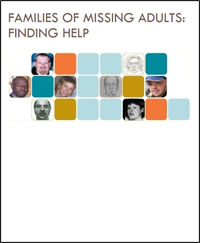 |
|
| Families of Missing Adults: Finding Help, by Ontario's Missing Adults (OMA) | |
Read pages 14-16 to learn more about using social media.
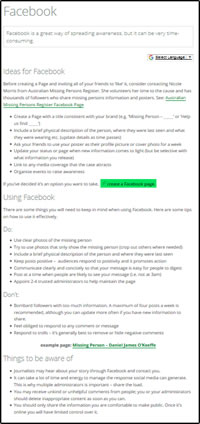 |
|
| Missing Persons Guide: Facebook, by the Missing Persons Advocacy Network (MPAN) | |
An online guide for families creating a Facebook page to support their missing loved one's case.
| << Prior Chapter | Next Chapter >> |
People who say it cannot be done,
should not interrupt those who are doing it.
— Author unknown

If you've been able to read this
Web page...
thank a Teacher;
If you've been able to read this
Web page in English...
thank a Veteran.
— Author unknown
Copyright © 1984-
March 23, 2021
by Michael A. Neiger
Contact Michael Neiger via e-mail at mneiger@hotmail.com
Top
You're here: MibSAR :: M-P Sourcebook Table of Contents :: Social Media